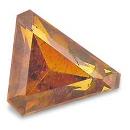|
Click on a letter above to view the list of gems. |
|
|
|
|
|
| Enhancements of Gems | |
|
| ||
|
| ||
|
|
Gemstone Enhancement Codes (based on AGTA guidelines) |
|
|
|
||
|
B Bleaching |
The
use of heat, light and/or chemicals or other
agents to lighten or remove a gemstone's
color.
This
is often accompanied by subsequent dying
and/or impregnation. |
|
|
|
||
|
C Coating |
The
use of such surface enhancements as lacquering,
enameling, inking, foiling, or sputtering
of films to improve appearance, provide
color or add other special effects. |
|
|
|
||
|
D Dyeing (Staining) |
The
introduction of coloring matter into a gemstone
to give it new color, intensify existing
color or improve color uniformity. |
|
|
|
||
|
E Normally Enhanced |
The "E" symbol is used for gemstones that are routinely enhanced. Since many enhancements are difficult or impractical to prove definitively, unless otherwise indicated, our approach is to assume that such enhancements have been applied to that particular gemstone. This assumption is made to protect both buyer and seller. If a more specific method of enhancement is known, then the specific enhancement code will be used. |
|
|
|
||
|
F Filling |
The
filling of surface-breaking cavities or
fissures with colorless glass, plastic,
or some similar substance.
This
process will improve durability, appearance
and/or weight. |
|
|
|
||
|
FH Flux healing |
During
heat enhancement, fluxes (or heat alone)
may be used to heal fractures/fissures which
were formerly open.
The
process dissolves the walls of the fractures
and redeposits the molten gem material,
healing the fractures closed. |
|
|
|
||
|
H Heating |
The
use of heat to alter color, clarity, and/or
phenomena. |
|
|
|
||
|
HP Heating & Pressure |
The use of heat and pressure combined to affect desired alterations of color and/or clarity. |
|
|
|
||
|
I Impregnation |
The
impregnation of a porous gemstone with a
colorless agent (usually plastic) to give
it durability and improve appearance. |
|
|
|
||
|
L Lasering |
The
use of a laser and chemicals to reach and
alter inclusions. |
|
|
|
||
|
N Not Enhanced |
The "N" symbol is used to indicate one of two situations. First, there are certain gemstones that are not currently known to be enhanced (alexandrite, some garnets, etc.) Second the "N" symbol may also be used for a gem where it can be proved via gemological or other means that a gem has not been subjected to any enhancement. |
|
|
|
||
|
O Oiling/Resin Infusion |
The
filling of surface-breaking fissures with
a colorless
oil, wax, resin or other colorless substances,
except glass or plastic, to improve the
gemstone's appearance. |
|
|
|
||
|
R Irradiation |
The
use of neutrons, gamma, ultraviolet and/or
electron bombardment to alter a gemstone's
color.
The
irradiation may be followed by a heating
process. |
|
|
|
||
|
U Lattice |
Outside-in
diffusion of coloring chemicals via high-temperature
heat treatment to produce color and/or asterism. |
|
|
|
||
|
W Waxing/Oiling |
The
impregnation of a colorless
wax; paraffin and/or oil in porous gemstones
to improve appearance. |
|
|
|
||
|
|
||
